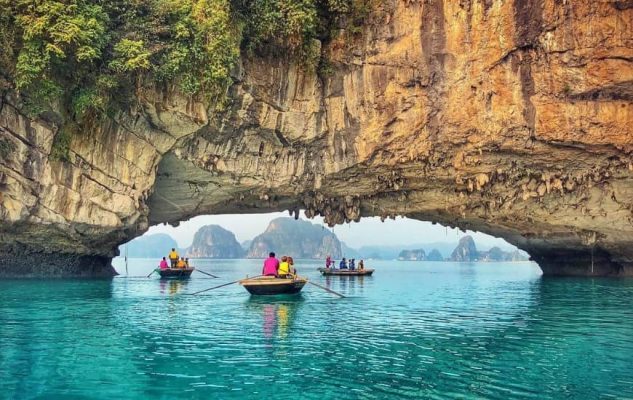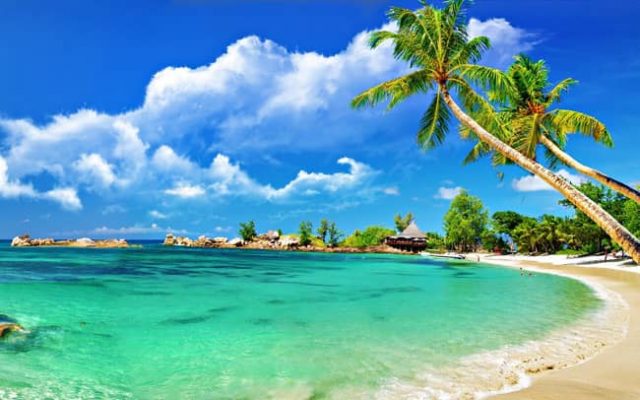
Vietnam Travel Guide
There are three most effective ways to choose the best time to visit Vietnam. Firstly, you can choose the time to visit Vietnam by region, and then you can determine the weather according to the destination you visit. Finally, it is you who determine by what month you will arrive. Ula Travel will bring you a complete guide to visiting Vietnam at the most ideal time in the article below; don’t miss it.
I. Best Time to Visit Vietnam Depends on the Region.
1. Mountainous Far North of Vietnam
(Sapa, Ha Giang, Bac Ha, and Mu Cang Chai)
The north-western region of Vietnam, including Sapa and Mu Cang Chai, experiences two distinct seasons.
- The dry season, from October to late March, offers the best conditions for travel.
- The wet season lasts from April to September. December and January can be particularly cold and frosty, especially at night.

Ha Giang is the leading tourist destination in Vietnam
For Ha Giang in the north-east, the optimal travel period is during the dry season from October to April, despite the chill in December and January. It’s advisable to avoid Ha Giang during the rainy season from May to September.
The best trekking conditions in Sapa and Mu Cang Chai are from September to November and March to May, with daytime temperatures ranging from 15 to 28°C and nighttime temperatures from 10 to 18°C. While trekking and cycling are possible year-round, winter can be quite chilly, and summer tends to be wet.
Click here: All Vietnam Tours
2. Northern Vietnam
(Hanoi, Halong Bay, Cuc Phuong, Mai Chau, and Ninh Binh)
Hanoi and the surrounding northern regions have a distinct winter and summer. The cool, mostly dry winter spans November to April, with average temperatures of 17–22 °C and the coldest months being January through March.

Halong Bay is most beautiful in the summer from May to October
Summer, from May to October, is hot and humid, with the highest rainfall occurring from July to September. During these wettest months, severe weather may occasionally prevent sailing in Halong Bay, though such weather events are rare.
Are you looking for: Tour Across Vietnam
3. Central Vietnam
(Hoi An, Danang, Hue, Dalat, and Nha Trang)
In Central Vietnam, Hoi An, Hue, and Danang experience hot and dry weather from mid-January to late August, with temperatures often reaching the mid-30s°C. The winter months see increased rainfall, peaking in October and November, sometimes accompanied by typhoons.

You should visit Hue in the dry season
Hue is generally cooler than Hoi An, particularly early in the year, and the weather can vary significantly due to their locations on opposite sides of a mountain range.
Nha Trang, located in the far south of Central Vietnam, enjoys a longer dry season from January to September with high temperatures and minimal rain. The rainy season, from October to early December, brings almost half of the annual rainfall, especially in October and November.
Dalat, situated in the central Highlands, experiences wet weather from June to October, making outdoor activities challenging. The period from November to May is much drier, though December and January can be cold.
Start your journey with: Vietnam Tour Package 14 Days
4. Southern Vietnam
(Ho Chi Minh City, the Mekong Delta, Phu Quoc, Phan Thiet, and Mui Ne)
Southern Vietnam has a consistent temperature range throughout the year, divided into two main seasons: wet and dry.
- The dry season runs from November to April or early May, with late February to May being the hottest and most humid period.
- The wet season lasts from May to early November, with the heaviest rainfall occurring from June to August. Rainfall during the wet season is typically heavy but brief, often in mid-afternoon downpours.

Phu Quoc Island.
Average temperatures in the south range from 25–35 °C year-round. The islands of Phu Quoc are pleasurable all year, with a high likelihood of sunny days; however, afternoon downpours are prevalent outside the dry season.
Conclusion:
Vietnam offers a diverse array of activities, culinary experiences, and affordable travel options. Planning your visit around the best times for each region will ensure a rewarding experience. For extended trips, consider timing your travels to explore different regions sequentially, such as moving to southern Vietnam after exploring the central areas.
You wil be like: Unforgettable Cross-Vietnam Tour in 11 Days
II. Best Time to Visit Vietnam’s Top Destinations.
1. Best Time to Visit Hanoi

Hanoi always welcomes visitors at all times with its unique climate
- Spring (March–May) and Autumn (September–November): These are the ideal times to visit Hanoi, featuring warm days, comfortable nights, and low humidity.
- Summer (June–August): Very hot and humid, making Hanoi feel oppressive in midsummer.
- Winter (December–February): cool and dry, suitable for visiting, but pack a jacket for chilly nights.
Do not miss: Vietnam All-in-One Tour – A Lifetime Journey Awaits
2. Best Time to Visit Halong Bay

Halong Bay
- March-May and September-November: ideal for Halong Bay cruises and outdoor activities with sunny, dry weather.
- June-August: hot, humid, and wet, with potential rain and storms affecting cruises.
- December–February: cool, with fog that may affect views but fewer crowds.
Are you ready for: Best Vietnam Discovery Tour
3. Best Time to Visit Ninh Binh

Ninh Binh
- March-August: hot and dry, perfect for exploring Ninh Binh’s rivers, mountains, and temples.
- September-November: some rain but comfortable temperatures and lush scenery.
- December-February: damp and chilly, less ideal but without crowds.
Come with us: Hanoi to Ninh Binh in 3 Days
4. Best Time to Visit Sapa

Trekking in Sapa
- March-May: the best trekking season with warm days, cool nights, and stunning valley views.
- September–November: excellent weather but a busier tourist season.
- June–August: rainy season with muddy and foggy trails.
- December–February: cold and foggy with occasional rain and snow.
Try it now: Hanoi to Sapa Private Tour
5. Best Time to Visit Da Nang

Tourism symbol of Da Nang
- January to August: hot, sunny beach weather is ideal for visiting Da Nang.
- September-December: More rain and occasional storms, but fewer tourists and still warm.
- April/May: peak heat. December/January: cooler nights.
Let’s explore: Da Nang to Hoi An in 4 Days
6. Best Time to Visit Hoi An

Hoi An
- February to August: warm, dry days perfect for beaches, city explorations, and lantern festivals.
- September to January: more rain and potential flooding, but fewer tourists.
- Late Spring: hot early winter, chilly at night.
Click here: Central Vietnam Wonders Tour
7. Best Time to Visit Hue

Hue Citadel
- February to August: generally dry with hot, sunny weather, perfect for exploring the imperial city.
- September to January: occasional storms and mist with humid, rainy days.
- March/April: peak hot season. December/January: cooler nights.
Let’s experience: Da Nang to Hue – Unexpected Trip You’ll Love
8. Best Time to Visit Nha Trang

Nha Trang
- January to August: most sunshine and blue skies, hot but dry.
- Late September to December: more storms and rain, but still warm for beach days.
- March to May: Very hot. December/January: cooler nights.
Read more: Nha Trang City Tour
9. Best Time to Visit Phu Quoc

Sunset at Phu Quoc island
- November to April (dry season): best beach weather with warm, sunny days and little rain.
- May to October (wet season): humid with frequent downpours and potential storms.
- January and February: cool nights. April and May are scorching hot.
You will be like: One-Day Phu Quoc Island Tour
10. Best Time to Visit Ho Chi Minh City

Ho Chi Minh City
- December to April (the dry season): ideal for exploring with hot but tolerable days and low humidity.
- May to November (Rainy Season): frequent afternoon thunderstorms and high humidity.
- March to May: extreme heat. December and January are relatively cool.
Do mot miss: Ho Chi Minh City Tour
III. Best Time to Visit Vietnam by Months
1. January – Cold Weather and Festive Celebrations
January brings cold winter weather to the north, often accompanied by persistent mists that may affect visibility, especially in Ha Long Bay. Despite the chill, it’s the driest time for trekking in mountainous areas like Sa Pa.

The last months of the year are the ideal time to visit Phu Quoc Island.
Southern Vietnam enjoys the dry season, making it perfect for exploring cities like Ho Chi Minh City and relaxing on beaches like Phan Thiet and Mui Ne. Water-related activities, such as diving, are popular around Phu Quoc. Nha Trang and Da Nang beaches also start to emerge from the rains.
2. February – Flower Blossoms and Lunar New Year
February offers optimal weather conditions across Vietnam. The southern and central coast regions are ideal for beach activities, with minimal rain. Meanwhile, the north experiences warmer temperatures, perfect for hiking and exploration.
The largest celebration in Vietnam, Tet, also known as Lunar New Year, takes center stage on the calendar. Even if the entire country is incredibly merry, keep in mind that many businesses, including restaurants and museums, close during this time. Additionally, because the Vietnamese enjoy long vacations and the transportation infrastructure is overburdened, it can be difficult to find lodging.
3. March – Water Sports and Beach Vacations
March is one of the best months to visit Vietnam due to favorable weather conditions nationwide. Rising temperatures in the north make it ideal for adventure activities in the highlands, while clear skies enhance experiences like boat tours in Ha Long Bay.

Phong Nha Caves
Dry weather in the south encourages beach visits and exploration of attractions like the Phong Nha Caves. Additionally, hot and sunny days make central coast beaches like Nha Trang popular destinations. The dry weather also makes it perfect for exploring outdoor activities and cultural sites across the country.
4. April – Spring Beauty and Cultural Festivals.
April sees rising temperatures across Vietnam, with some rain in the north. However, it remains pleasant for hiking, with spring flowers in full bloom, making the region especially beautiful.
Central Vietnam offers blue skies and sunshine, perfect for exploring towns like Hoi An and relaxing on its beaches. Further south, Nha Trang experiences its best weather, while Hue enjoys agreeable temperatures. Additionally, April marks the time for various cultural festivals across the country, offering visitors a chance to immerse themselves in Vietnamese traditions.
5. May – Ethnic Markets and Mountain Getaways.
May marks the transition to the monsoon season in southern Vietnam, while the north becomes hotter with increased rainfall. Despite this, outdoor exploration remains popular, especially in the mostly dry north.

Highland market
The central coast offers hot and sunny days, ideal for beach activities and exploring ethnic markets. During this time, visitors can also experience the unique culture of ethnic minorities in the mountainous regions.
6. June – Diving Excursions and Island Getaways.
June brings the rainy season to the south and increased rainfall to the central highlands. However, the central coast remains inviting for beachgoers, and the north experiences mostly dry weather. This makes it an ideal time for island retreats and diving adventures in the south.
Despite occasional showers, the central coast is perfect for beach activities near Hoi An, Da Nang, and Lang Co. Hanoi and the Mai Chau Valley remain mostly dry, with fewer tourists. June also offers unique opportunities to experience local life and cultural festivities, particularly in rural areas.
7. July – Highland Explorations and Summer Festivals.
July experiences heavy downpours at both ends of the country, with peak temperatures in the north. Despite the rain, beach visits are still possible in the south, and trekking conditions remain favorable in the north.
However, transport may be complicated by road closures caused by heavy rain, especially in remote areas. Hanoi tends to experience very wet conditions during this month. July also marks the beginning of various summer festivals across Vietnam, offering travelers a chance to immerse themselves in local traditions and celebrations.
8. August – Local Life Experiences and Culinary Explorations.

Nha Trang is most beautiful from January to September
August sees peak rainfall in the north and central highlands, making it unsuitable for trekking. However, the central coast, particularly Nha Trang, still offers good weather for beach activities. This is also an ideal time to explore Vietnam’s diverse culinary scene and immerse yourself in local life and traditions.
In the south, despite the wet season, there are still plenty of rain-free hours for exploration. August also offers opportunities for cultural experiences, such as participating in traditional cooking classes and visiting local markets.
9. September – Views of the Rice Harvest and Photography.
September marks the beginning of the best time to visit Vietnam, with temperatures rising and rainfall decreasing. It’s an ideal time for trekking in the north, around Sa Pa, but the central coast experiences heavy rain and storms.

Sapa harvest time
Despite the rain, September offers unique opportunities for photography, especially in rural areas where rice harvest views are stunning. Visitors can also participate in local festivals and cultural events, providing insights into Vietnam’s rich heritage and traditions.
10. October – Outdoor Activities and Nice Weather.
October offers favorable weather conditions for outdoor activities like trekking in the north. However, heavy rain and storms may affect central coast destinations like Hoi An and Da Nang.
Despite occasional showers, October is a great time to explore Vietnam’s diverse landscapes and cultural sites. Visitors can also enjoy outdoor activities such as cycling, hiking, and exploring national parks.
11. November – Less-Crowded Tours and Historical Sites.
Balmy temperatures in the south and favorable conditions in the north make November an ideal month for visiting Vietnam. Cruises at Ha Long Bay are particularly popular during this time.
However, the central coast experiences the onset of the wet season, with dangerous riptides between Da Nang and Hoi An. November also offers opportunities to explore Vietnam’s rich cultural heritage, with fewer crowds at popular tourist sites.
12. December – Cool-Weather Hiking and Holiday Spirit.
December brings mostly dry conditions to Vietnam, with sunshine and comfortable temperatures. It’s an excellent time to visit the southern coast for beach activities. Ho Chi Minh City offers pleasant temperatures for exploration, while outdoor activities in the north remain viable, albeit somewhat chilly, especially in the mountains.
Travelers should plan ahead for Christmas getaways due to the high demand for accommodations. Furthermore, December provides possibilities for festive celebrations and feeling the Christmas spirit throughout Vietnam’s cities and towns.
In conclusion, the period from November to April generally offers the most favorable weather nationwide, characterized by sunny, dry days, low humidity, and fewer crowds. Conversely, the summer months, spanning from June to August, are marked by intense heat, high humidity, and heavy rainfall, while the transitional shoulder months may witness some precipitation.
When choosing the best time to visit Vietnam, it’s crucial to consider the regional and monthly weather variations to select appropriate destinations and ensure an optimal experience. Flexibility regarding hot or wet conditions is advisable. With strategic timing, Vietnam presents opportunities for exceptional travel experiences and stunning scenery throughout the year.
See more: Vietnam Overview






















